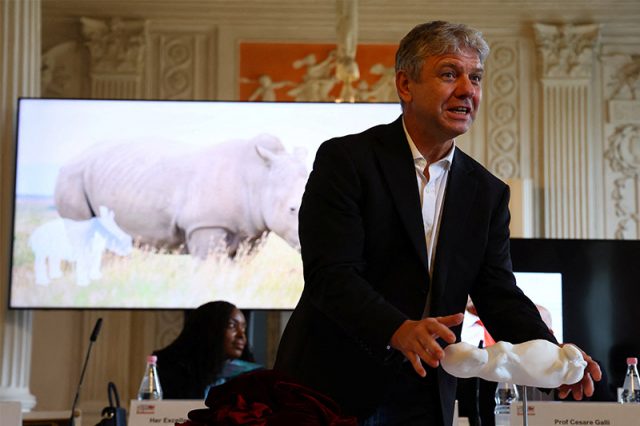
BERLIN — Scientists in Berlin on Wednesday announced the first successful embryo transfer in a white rhinoceros using a method that offers hope for saving the critically endangered northern white rhino subspecies from extinction.
The white rhinoceros includes two distinct subspecies, northern and southern. The last male northern white rhino died in 2018, with only two female members remaining. Neither are able to carry a calf to term. Southern white rhinos are more abundant.
The scientists turned to in-vitro fertilization, harvesting the eggs of female northern white rhinos and using sperm from dead male rhinos of the subspecies to produce embryos that eventually will be transferred to southern white rhino surrogate mothers.
By way of proof of concept, the scientists said they transferred the embryo of a southern white rhino into a surrogate mother of that subspecies at the Ol Pejeta Conservancy in Kenya on Sept. 24, 2023.
The international BioRescue team, backed by the German government, confirmed on Wednesday that the procedure had produced a successful pregnancy of 70 days, with a well-developed 6.4 cm (2.5 inch)-long male embryo.
“We achieved together something which was not believed to be possible,” said Thomas Hildebrandt, who heads the reproduction management department at the Leibniz Institute for Zoo and Wildlife Research, speaking to reporters at a press conference at Berlin’s Tierpark zoo.
“That is really a milestone to allow us to produce northern white rhino calves in the next two, two and a half years,” Hildebrandt said.
Northern white rhinos, which despite their name are actually grey, used to roam freely in several countries in east and central Africa, but their numbers fell sharply due to widespread poaching for their horns.
The BioRescue consortium has been racing against time to save the subspecies.
The proof of concept allows them to now safely move to the transfer of northern white rhino embryos, the scientists said.
— Reporting by Michele Sani; Writing by Rosalba O’Brien; Editing by Will Dunham








